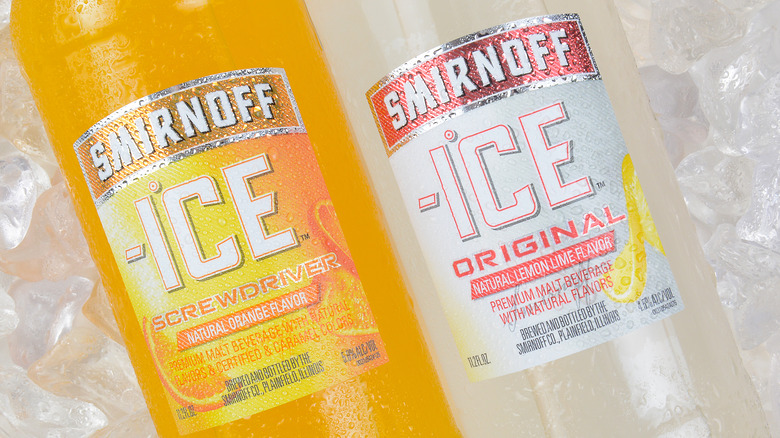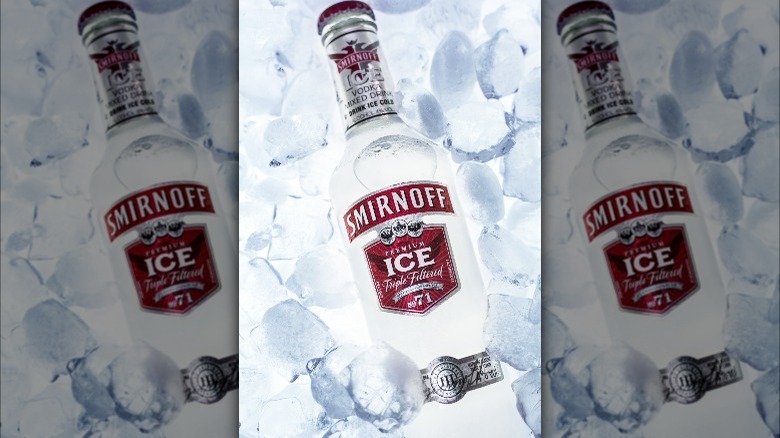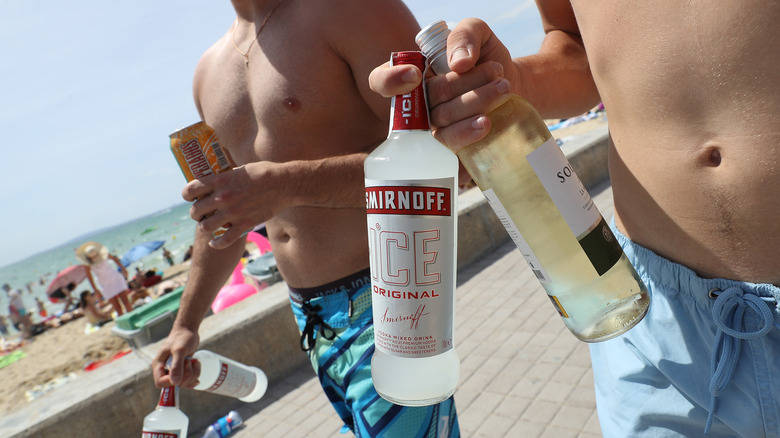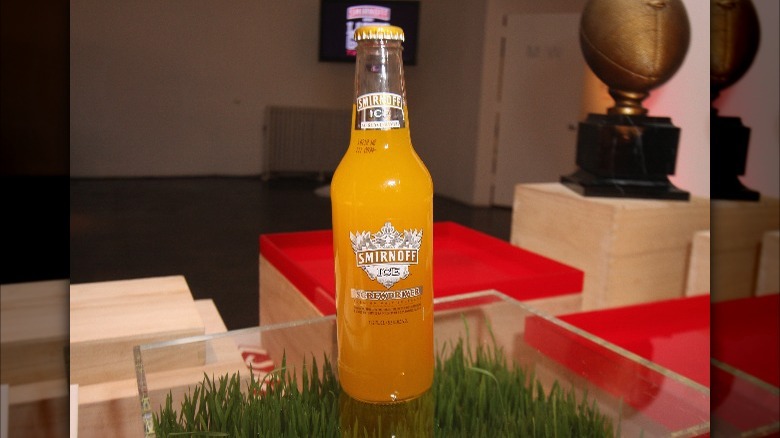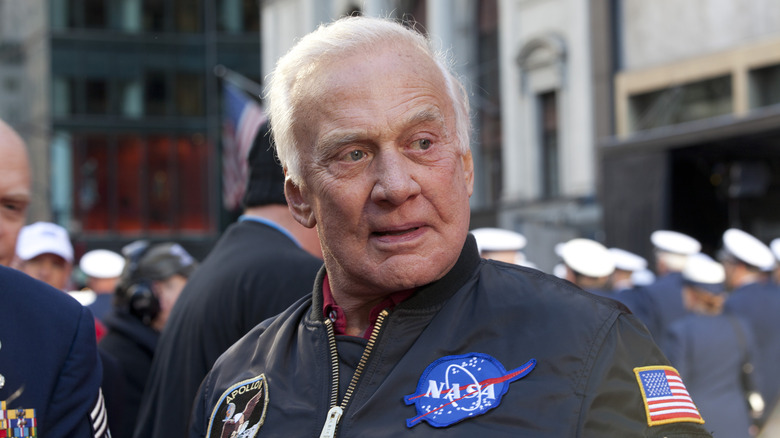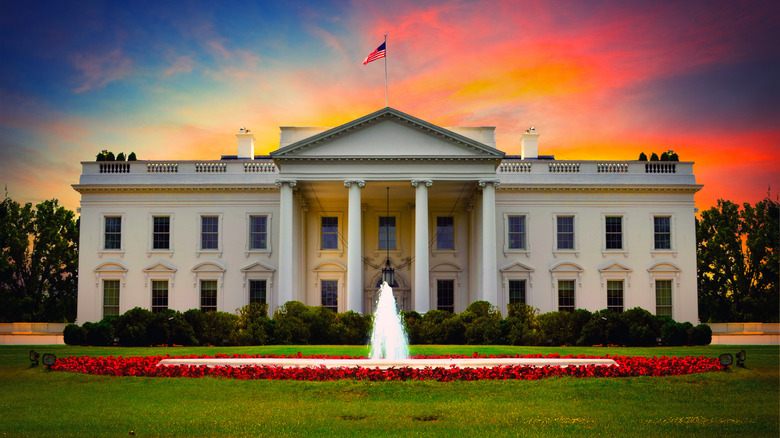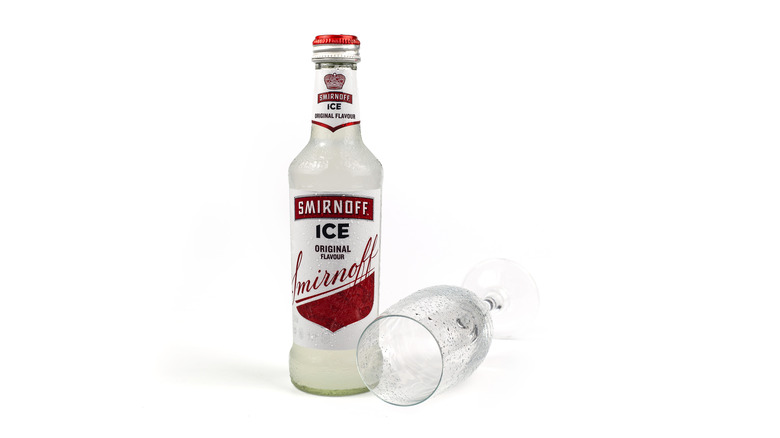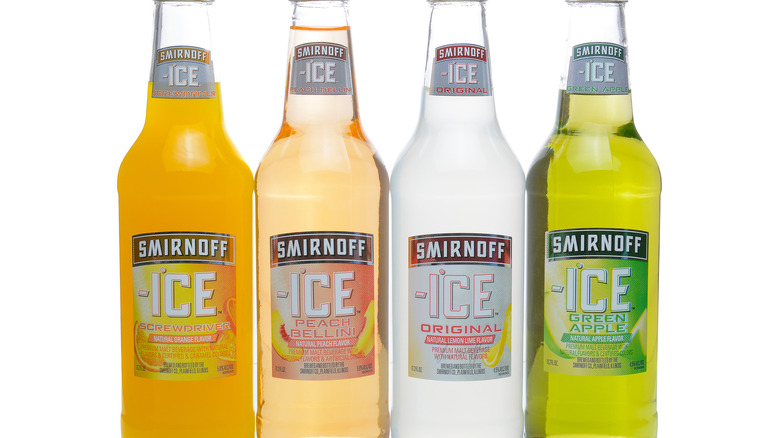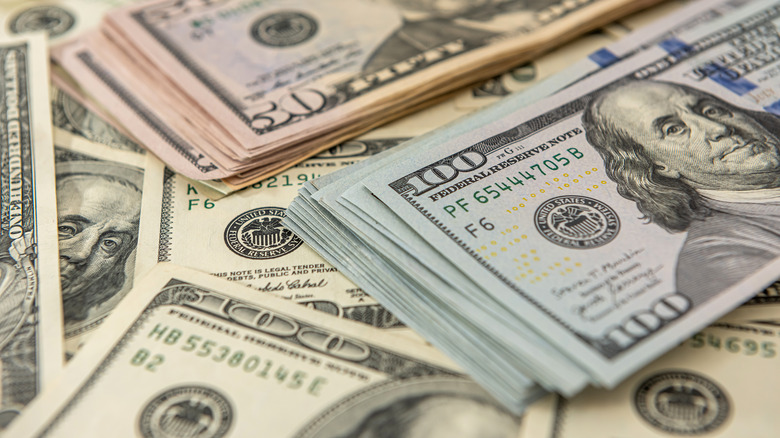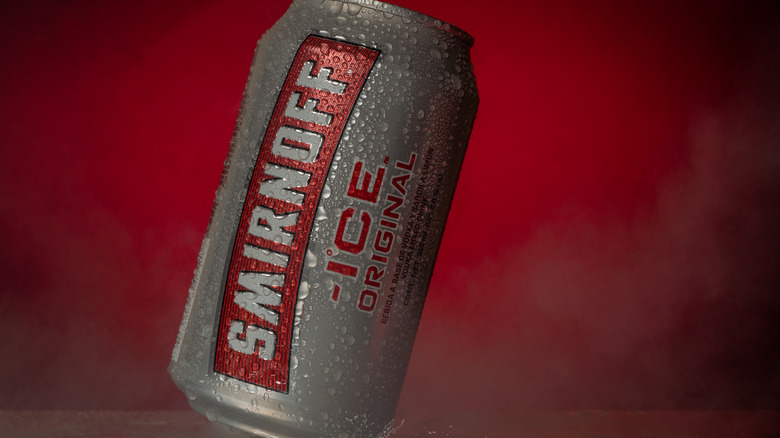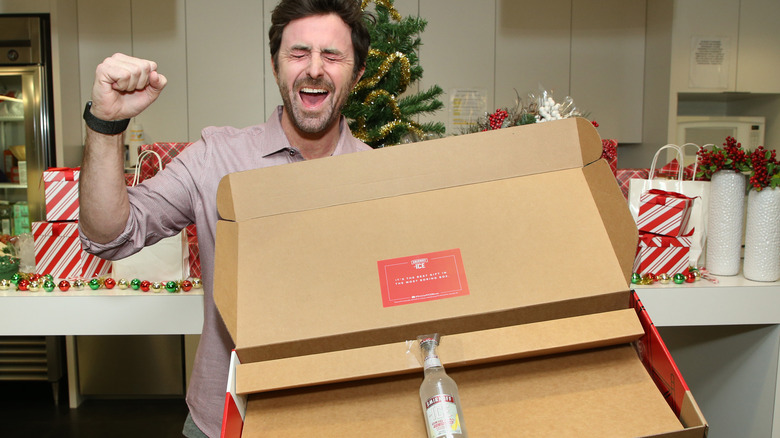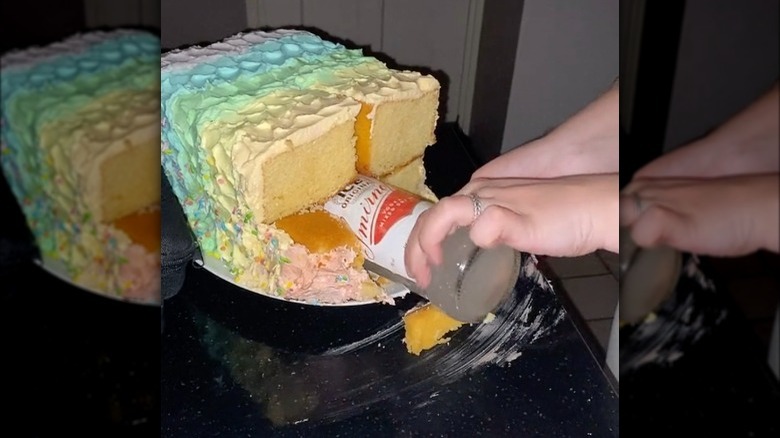The Untold Truth Of Smirnoff Icing
It might be hard to remember this now, when fruity, sparkling alcoholic beverages like spiked seltzers rule the booze landscape, but for a long time, sweet beer alternatives were viewed with scorn and derision. Before it became socially acceptable for people (especially men) to drink something like a White Claw in public, the sight of a malternative like Zima in a bro's hand could be an excuse for (hyper-gendered, often misogynistic and/or homophobic) mockery. Smirnoff's entry into the alcopop market, Smirnoff Ice, was not exempt from this kind of shaming.
While Smirnoff Ice has always been relatively popular and wasn't a legendary flop like Zima, it definitely wasn't viewed as a cool thing to drink in 2010. Back in those less enlightened times, Smirnoff Ice's reputation as gross swill became the basis of Smirnoff Icing, a game that involved forcing your friend to chug a bottle (or two), often in an inappropriate location (via The New York Times). The joke relied on the premise that the consuming Smirnoff Ice could only be a punishment, as it was disgusting and "girly." With Icing back in the zeitgeist because of TikTok (in a less hyper-masculine context), it's only appropriate to roll back the clock and look at Smirnoff Icing's bro-tastic history.
It all started with an email to BroBible
First off, we must acknowledge that when this drinking game started, it was not called "Smirnoff Icing." No, back in the bad old days of 2010, it was called "Bros Icing Bros." As much as this prank has transcended its frat boy roots, it very much started as a trick that fraternity brothers played on each other.
Unlike most other drinking games, the origins of Smirnoff Icing can be precisely traced back to the very beginning. That beginning, we're sorry to say, was an email from some frat bros at the College of Charleston in South Carolina to the website BroBible. The email laid out the two crucial rules of the game: First, that if a friend surprises you with a Smirnoff Ice, you must immediately drop to one knee and drink it, regardless of the setting. Second, if you happen to have a Smirnoff Ice on your person when somebody attempts to Ice you, that unlucky trickster must drink both your Ice and the one they tried to prank you with.
Although the original email to BroBible hid the identity of Smirnoff Icing's inventor, quite soon after that, a South Carolinian who identified himself to Fortune as "Joe" registered the brosicingbros.com domain name. Whether or not Joe was the true inventor of the fad, he certainly brought it to the mainstream.
The craze quickly spread across college campuses
If "Joe" was indeed Patient Zero for Smirnoff Icing, he was very infectious. His original email to BroBible was sent in Spring 2010. Per a blog post from Orlando's University of Central Florida Knight News, the game had wound its way to the Sunshine State by May of that year. A YouTube video entitled "How to Ice a Bro" was posted in June, a few weeks after reporters began to catch on to the Icing trend (via The Village Voice). In the video, a bro in Missouri enacts a complicated scheme involving the United States Postal Service to Ice his bro who goes to Harvard. This suggests that the Icing meme was already widespread among college students by mid-year, as the video involves people who go to school in Missouri and Massachusetts, and Icing was invented in South Carolina.
It's safe to say that Icing took over America's college campuses swiftly after its invention. It wouldn't stay confined to the ivory tower for long, however.
Wall Street also had a big Icing phase
According to CNBC, being in a fraternity could make you more likely to pursue a career in finance. It's no surprise, then, that Smirnoff Icing quickly made the leap from fraternity houses to Wall Street banks. In May 2010, towards the beginning of the Icing phenomenon, Fortune reported that employees at Goldman Sachs, Raymond James, and the hedge fund D.E. Shaw had all been iced.
With their neighbors in the financial district hopping on the bandwagon, it was natural for New York City advertising professionals to try to get a piece of the action too. Colin Nagy, who at the time worked for the Manhattan-based social marketing firm Attention, bought the domain name iceashton.com in an effort to convince the internet to bully Ashton Kutcher into chugging a Smirnoff Ice (the efforts were unsuccessful). A marketing professor told Fortune that the Icing phenomenon caught on because it targeted "certain individuals that define social structures and drive the decisions other consumers make."
College students carried bottles of Smirnoff Ice in their backpacks as self-defense
As noted above, the only way to defend yourself from Icing is if you have possession of a prophylactic Smirnoff Ice. In that case, your would-be Icer not only has to drink the Ice they foisted on you, but your Ice as well. Joe, the pseudonymous creator of brosicingbros.com, told Fortune that at the height of the craze, students would carry bottles of Smirnoff Ice in their backpacks at all times to preemptively thwart any surprise Icing attacks.
While these protective Smirnoff Ices were undoubtedly a smart defensive strategy, they may have only invited more Ice-based attacks. After all, if you wanted to strike an offensive blow in the Ice wars, all you would need to do was turn your defensive Ice into a weapon by presenting it to an unprepared bro. Like most arms races, Bros Icing Bros was a zero-sum game.
The co-founder of Foursquare tried to Ice Buzz Aldrin
Of course, bro culture isn't limited to college campuses and investment banks. Silicon Valley has its own species of bro as well. The Village Voice reported that this was illustrated in truly cringe-inducing fashion at the 2010 Webby Awards. Naveen Selvadurai, the co-founder of Foursquare, tried to Ice Buzz Aldrin, the famous astronaut, American hero, and second man to walk on the moon. Aldrin did not accept the challenge, because, as Biography notes, he stopped drinking in 1978 after struggling with alcoholism (presumably Selvadurai didn't know this important fact).
As an aside, can we as a culture just collectively agree to stop harassing Buzz Aldrin? The Icing incident happened eight years after an infamous confrontation between Aldrin and the moon landing conspiracy theorist Bart Sibrel that resulted in Aldrin punching Sibrel in the face after he called the astronaut a "thief, liar, and coward" (via the Orlando Sentinel). After two decades in the Air Force and several missions to space, surely the man has earned the right to relax.
Smirnoff Icing even made it to the White House
After conquering America's institutions of higher learning, its temples of commerce, and its technological innovators, it was only natural for Icing to ascend to the highest rung of American power: the White House. In 2018, a staffer at the Presidential Personnel Office, an agency involved in hiring executive branch employees, iced another staffer at an office happy hour (via Vinepair). Spokespeople for the White House confirmed to The Washington Post that the Icing in question did happen, clarifying that it was done "to celebrate the deputy director's 30th birthday." Ah yes, it was somebody's birthday. That totally makes it acceptable to play a drinking game at your very important government job.
According to The Washington Post, the Icing incident only scratched the surface of the problems with unprofessionalism among the Presidential Personnel Office's leadership in 2018. One person present at the birthday happy hour had previously written bad checks and been arrested for driving under the influence, a rap sheet that looks tame compared to their colleague, who had a record of "assault, disorderly conduct, fleeing an officer, and underage drinking."
The trend was rooted in some regressive ideas about gender
As one might expect from a game originally called "Bros Icing Bros" that was concocted by fraternity brothers in 2010, Smirnoff Icing wasn't exactly grounded in progressive gender politics during its first phase of popularity. As Knight News, the University of Central Florida's student paper, put it in 2010, Icing hinges on forcing a bro to "chug the girly beverage — which many men find tastes disgusting — right there on the spot." The humor value of Icing a bro was predicated on the unfounded assumption that Smirnoff Ice was for women only, as though people of other genders wouldn't enjoy a carbonated alcoholic beverage that tasted like soda.
The heavily-gendered basis of the Icing prank was further explored by Drew Magary at Deadspin (in a post that, ironically, contains ample use of dated, offensive language itself). Magary argued that Icing was homophobic, and that while many who participated in the trend tried to do so ironically, they were still complicit in Icing's unsavory ideology.
There was an inevitable backlash
Any trend, if it stays around long enough, will eventually receive some kind of backlash. Just as America turned its back on sun-dried tomatoes after being fed them at seemingly every restaurant in the 1980s, the public would begin to scorn Icing soon after it exploded into the cultural consciousness ( via The Village Voice). The aforementioned Deadspin article, in addition to criticizing the game's bro ideology, also calls Icing "stupid," and accuses the people willingly taking part in it of being "sheep." Keep in mind that the article was posted in June 2010, mere weeks after the game first achieved prominence. The backlash cycle against Icing happened quickly.
Of course, there were some legitimately concerning aspects about Icing, especially in its initial "Bros Icing Bros" incarnation. CBS opined that the game seemed to encourage excessive drinking among young people. There's also just something inherently uncool about surprising somebody with alcohol and expecting them to drink it on the spot. The attempted Icing of Buzz Aldrin illustrated just one of the many ways that trying to force someone to drink alcohol without their consent could be problematic.
The inventors of Smirnoff Icing tried to cash in on its popularity
Another nail in the coffin for the initial wave of Smirnoff Icing's popularity was the sudden and mysterious demise of brosicingbros.com in June 2010. The site, which hosted photos of bros Icing each other, had been generating a lot of traffic, and the brand had racked up an impressive-for-the-time 20,000 likes on Facebook (via BroBible). A couple of days before the site went down, the owners reached out to BroBible, offering to sell them the website for "a minimum of five figures." BroBible declined, and soon after that, all the content at the domain was replaced by a blank page with one sentence of text: "We had a good run bros ..."
AdAge reported that Smirnoff was involved in the site's closure. As The Village Voice noted, the site had begun selling merch with the Smirnoff Ice logo on it in an apparent violation of Smirnoff's copyright protections. A representative from Diageo, which owns Smirnoff, told the publication that "we'll take whatever actions we consider necessary or appropriate to defend our intellectual property rights." It seems as though the attempt to sell the domain name may have been a last-ditch effort to cash out before the Bros Icing Bros team had to fold under legal pressure from Diageo.
Smirnoff distanced itself from the Icing trend
Since Icing put Smirnoff Ice in the limelight, some people speculated that it may have started as a Smirnoff-led marketing stunt rather than as an organic consumer trend. Gawker cited a contemporaneous viral marketing scheme from shoe manufacturer Hi-Tec as evidence that this could be the case. However, Diageo went to great pains to emphasize that it had nothing to do with inventing the game.
As CBS discussed, the Smirnoff Icing's association with binge drinking wasn't something Smirnoff wanted to encourage. Also, the fact that part of the "humor" of the game was that Smirnoff Ice was supposed to be nasty wasn't a great look for the brand. Diageo spokesperson Zsoska McDonald emphasized to Fortune that the Smirnoff brand had nothing to do with starting the Icing trend, saying, "The icing phenomenon is consumer generated." She also discouraged underaged Icing in her statement, clearly indicating that Smirnoff wanted no part in any inappropriate or dangerous behavior.
But Smirnoff also slyly referenced it in their marketing
Although Diageo officially washed their hands of the Smirnoff Icing fad, the brand has seemed to capitalize on the game's notoriety in its advertising on multiple occasions. In spring 2010, the Smirnoff Facebook page posted messages that CBS speculated could be intended to reference Icing. The most blatant of these were "This summer Smirnoff Ice could crash your party" and "This summer, uncap the unexpected."
Later on, the Icing tributes in Smirnoff's marketing became more blatant. In 2019, the brand released a line of gag gifts that were basically ready-made Smirnoff Icing kits. The gifts took the form of a cardboard box that, on the outside, looked like a luxurious set of wooden hangers or a hand mixer from the fictitious brand Cremsiffino (an anagram for Smirnoff Ice). Inside the box lurked a surprise bottle of Smirnoff Ice. The brand did a variation on the same stunt the next year, releasing a line of jigsaw puzzles that had a surprise picture of a bottle of Ice hidden somewhere in the image.
Icing is now popular with the TikTok generation
The timeline for nostalgia-based comebacks seems like it's getting shorter every year, and one piece of evidence for that is that the Icing trend is already seeing a resurgence just barely a decade after its first run. As with all contemporary pop culture, Gen Z is taking the reins this time, and they're doing it on TikTok. Instead of "Bros Icing Bros," it's now called the "Smirnoff Ice Challenge."
Videos with the Smirnoff Ice Challenge hashtag have racked up over 37 million views on the app. An overview of some of the videos reveals that it's not just bros Icing each other in 2021, as many women are represented in the Icing Challenge videos. There's also an Icing spinoff called "Oating," in which TikTokers surprise each other with raw oats (via Insider). The recipient is expected to pour the oats over their head.
It remains to be seen how long the Icing trend's second wave will endure; since Internet trends these days seem to last about five seconds before everyone moves on, it may be only a brief moment in the sun. Is anybody still making that baked Feta pasta anymore?
